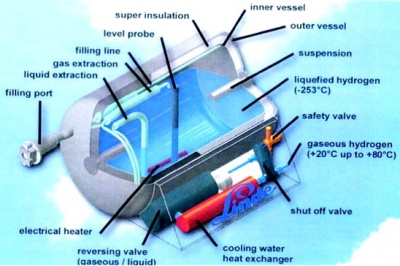Difference between revisions of "Wahid Amir Chairudin"
Wahid.amir (talk | contribs) |
Wahid.amir (talk | contribs) |
||
| Line 32: | Line 32: | ||
== Design & Optimization of Pressurized Hydrogen Storage == | == Design & Optimization of Pressurized Hydrogen Storage == | ||
| − | + | [[File:H2Storage.jpg|400x400px]] | |
'''Objective''' : | '''Objective''' : | ||
Revision as of 22:35, 1 June 2023
Introduction
Perkenalkan nama saya Wahid Amir Chairudin, biasa dipanggil Wahid
Saya lahir di Kota Surakarta pada tanggal 10 April 2002
Saat ini selama saya menjalankan perkuliahan, saya bertempat tinggal di rumah indekos di daerah Kukusan, Beji, Depok.
Saya adalah mahasiswa Program Studi Teknik Perkapalan - Fakultas Teknik Universitas Indonesia, dengan NPM 2106708570
Resume Perkuliahan 1 - 26 Mei 2023
[Tempat Perkuliahan : Gedung S.305 || Waktu Perkuliahan : 16.00 - 17.40]
Pada pertemuan pertama ini kita membahas beberapa hal terkait dengan introduction dan konsep dasar pembelajaran di kelas Metode Numerik.
Di awal kelas Pak Ahmad Indra Siswantara (DAI) memberikan penjelasan tentang ketertarikan mahasiswa terhadap mata kuliah metode numerik. Pak Dai menekankan bahwa sebagai mahasiswa kita harus memaksimalkan potensi diri kita selagi usia kita masih muda dan berusaha semaksimal mungkin untuk memahami apa yang sedang kita pelajari dan kita ikuti selama menajalani kelas perkuliahan.
Di masa kini, ada teknologi yang dinamakan Chat GPT yang dapat kita gunakan secara maksimal untuk mendapatkan dan mencari data - data konkrit dari sebuah materi yang kita bingungkan.
Pak DAI juga menjelaskan terkait dengan metode ujian yang nantinya akan diterapkan di kelas yang beliau ampu. Metode ujian yang digunakan adalah "Blank Paper Question Sheet" dimana mahasiswa diberikan kesempatan untuk menulis dan membuat materi serta pertanyaan yang akan dibuat masing - masing oleh mahasiswa mengenai segala macam ilmu yang sudah didapatkan selama mengikuti kelas perkuliahan. Pak DAI mengharapkan mahasiswa mengerti tentang materi yang sudah disampaikan selama mengikuti perkuliahan dan dituangkan kedalam kertas yang diberikan.
Pak DAI pada pertemuan pertama juga menunjuk beberapa mahasiswa untuk menjelaskan apa yang mereka dapat selama mengikuti kelas perkuliahan Metode Numerik.
Kemudian, Pak DAI juga me-remind tentang materi apa yang dikirimkan di Grup WA dan juga menjelaskan sekilas tentang penugasan kepada mahasiswa untuk membuat dan mengoptimasi tabung hydrogen yang diberikan batasan berupa produksi dari tabung tersebut harus kurang dari Rp500.000 . Alasan tugas ini diberikan karena mengingat energy hydrogen ini di masa depan diharapkan bisa menjadi solusi energi yang tidak menimbulkan polusi dan juga tidak menjadi sampah akibat pertukaran energi.
Pada akhir sesi perkuliahan Pak DAI memberikan case study dan juga analogi pendekatan yang menginspirasi mahasiswa untuk lebih giat dalam menuntut ilmu dan juga mendekatkan diri kepada Tuhan YME, agar di dalam perjalanan perkuliahan kita senantiasa mengingat bahwa segalanya tidak ada yang sempurna dan pasti kecuali Yang Maha Esa.
Design & Optimization of Pressurized Hydrogen Storage
Objective : Design and Optimization Of Pressurized Hydrogen Storage
Spesification :
Capacity : 1 Litres
Pressure Level : 8 bar
Limitation : Cost should not exceed Rp.500.000
Week 1 Progress
In week 1 I did some research on Hydrogen Storage and some of the limitations that have been set for this assignment. I Consciously think that to collect some data related to what needs are needed to understand the basics of designing and optimizing Hydrogen Storage. There are lots of considerations that must be collected and must be researched if we want to optimize a product that already exists. Collecting data in a short time will certainly be a challenge. This is where I have a solution for using AI technology that is being widely discussed in the world, namely the GPT Chat. GPT Chat provides many outlines of considerations that we can use in designing and optimizing a tool or product.
ChatGPT Response
ChatGPT provides several considerations and steps that we can take and examine in optimizing Hydrogen Storage. Among them are: Tank Selection, Tank Material, Tank Safety, Cost Optimization, and several other additions
System Requirements
The initial system requirements that must be considered before designing and optimizing Hydrogen Storage include the selection of tanks and their materials, pressure regulators, valves and fittings as well as safety features that are applied to the Hydrogen Storage.
Storage Method
In this case the storage method that we can use within the limits specified above is Cryogenic Tanks where this storage method involves storing hydrogen in liquid form at very low temperatures. Cryogenic tanks, often insulated vessels, are used to store and maintain hydrogen in its liquid state.
Material Selection
Choose a gas cylinder made of steel, as it is generally more affordable than other materials like aluminum alloy. Steel cylinders are widely used for compressed gas storage and offer good strength and durability.
System Design
In developing and optimizing the detailed Hydrogen storage for storage systems, we consider factors such as vessel shape, internal volume, structural integrity, valve placement and fitting, thermal management, and pressure relief mechanisms. The design software that can help us to do the design is computer-assisted (CAD) which can also be combined with other mechanical analysis software such as Ansys or other CFD analysis.
Safety Measures
Ensure that the selected tank has proper safety features, such as pressure relief mechanisms and valves, to prevent over-pressurization. It should comply with safety standards like ISO 11119 for gas cylinders, ISO 16111 or ASME Boiler and Pressure Vessel Code.
Optimization Techniques
To optimize your hydrogen storage design for cost-effectiveness and compactness, you can follow these steps:
- Determine Storage Requirements,
- Evaluate Different Storage Methods,
- Assess Material Choices,
- Optimize Cylinder Size,
- Utilize Standardized Components,
- Explore Economical Manufacturing Processes,
- Consider System Integration,
- Conduct Cost-Benefit Analysis,
- Safety and Compliance,
- Continuous Improvement.
Manufacturing Process
Investigate cost-effective manufacturing processes, such as mass production techniques, to reduce production costs. Optimizing manufacturing processes can lead to cost savings and increased efficiency
Performance Testing
To optimize hydrogen storage for cost-effectiveness and compactness through performance testing, you can follow these steps:
- Define Performance Metrics,
- Establish Test Procedures,
- Conduct Comparative Testing,
- Analyze Test Results,
- Iterative Design Optimization,
Based on the test results and analysis, iterate the design optimization process. Modify or refine the design elements to improve cost-effectiveness and compactness while maintaining desired performance levels. Consider factors like material selection, geometry, insulation, and pressure control mechanisms.
Regulatory Compliance
Regulatory compliance is essential when designing and optimizing hydrogen storage systems to ensure safety, environmental protection, and adherence to applicable laws and regulations. Here are some key considerations for regulatory compliance in designing and optimizing hydrogen storage :
- Familiarize Yourself with Regulations,
- Safety Standards and Codes,
- Pressure Vessel Regulations,
- Hazardous Materials Transportation Regulations,
- Environmental Regulations,
- Permits and Approvals,
- Third-Party Certification,
- Documentation and Record-Keeping,
- Ongoing Compliance Monitoring,
- Consultation with Experts.
Lifecycle Considerations
When designing and optimizing hydrogen storage systems, it's crucial to consider lifecycle considerations to ensure the long-term performance, sustainability, and cost-effectiveness of the system. Here are key lifecycle considerations to keep in mind:
- System Durability and Reliability,
- Maintenance and Inspection,
- Efficiency and Performance Optimization,
- Safety Management,
- Environmental Impact,
- End-of-Life Considerations,
- Cost Analysis,
- Technological Advancements,
- Regulatory Compliance.
Continuous Improvement
Continuously seek opportunities for improvement through feedback, monitoring, and technological advancements. Stay updated with the latest developments in hydrogen storage technologies to identify cost-effective and compact solutions.

